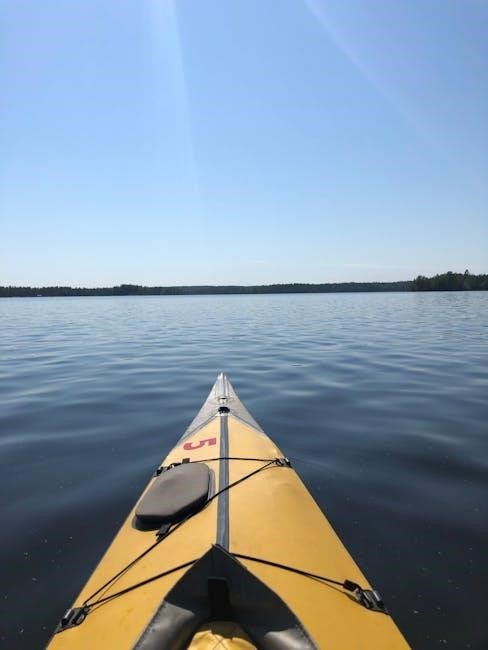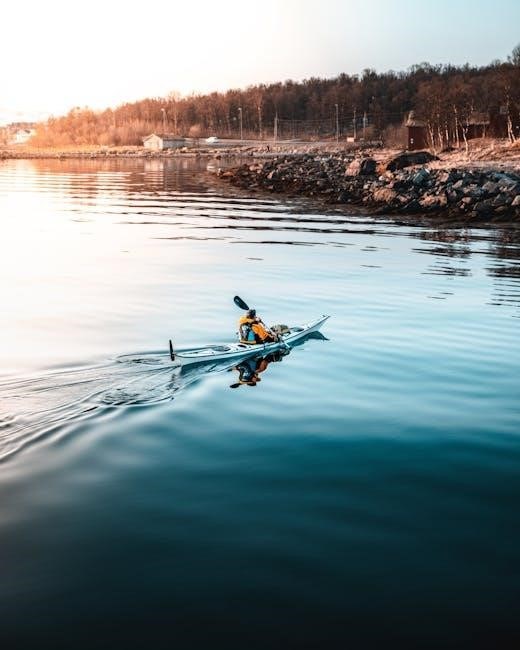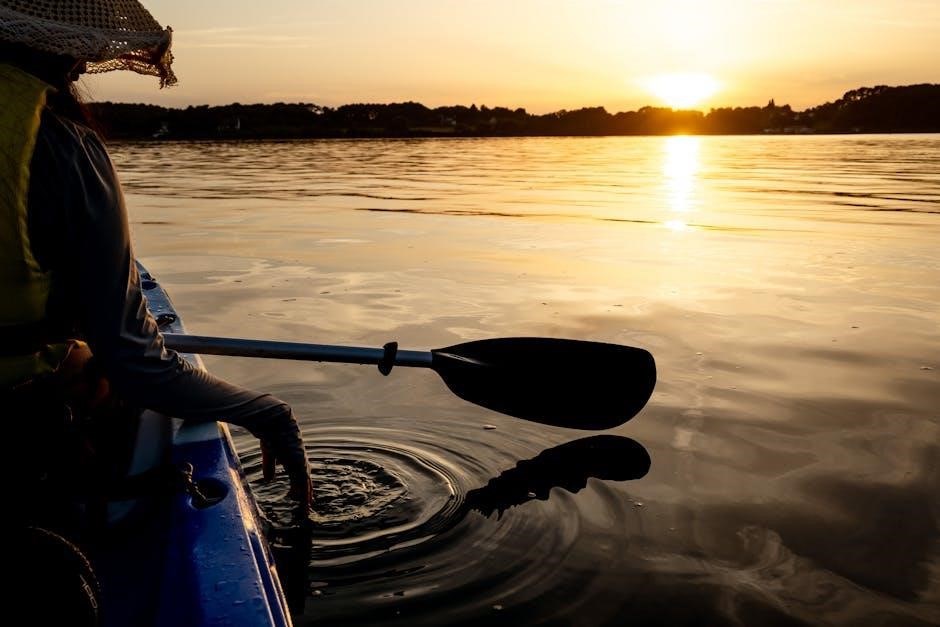
guide to purchasing a kayak
Purchasing a kayak involves understanding your needs, such as the type of water and intended use. Consider factors like stability, maneuverability, and durability to make an informed decision.
1.1 Understanding the Importance of Choosing the Right Kayak
Selecting the right kayak is crucial for a safe and enjoyable experience. The wrong choice can lead to discomfort, poor performance, or even safety risks. Consider factors like stability, durability, and maneuverability based on your paddling environment—rivers, lakes, or oceans. A kayak that matches your skill level, whether you’re a beginner or an advanced paddler, ensures better control and confidence on the water. Investing time in research and test paddling helps you find a kayak that aligns with your needs and preferences, enhancing your overall kayaking experience.
1.2 Brief Overview of Kayak Types and Uses
Kayaks vary widely, catering to different paddling styles and environments. Recreational kayaks are great for calm waters like lakes and slow rivers, offering stability and ease of use. Touring kayaks are designed for long-distance travel on open waters, emphasizing speed and tracking. Inflatable kayaks provide portability and versatility, ideal for casual use. Each type serves specific purposes, ensuring there’s a kayak suited for every paddler’s needs, from leisurely outings to adventurous expeditions, making it essential to choose the right one for your intended use.

Research and Planning
Research is crucial to find the right kayak. Start by identifying your kayaking needs, preferences, and budget. Understand the types of kayaks and their uses to narrow your options and make an informed decision.
2.1 Identifying Your Kayaking Needs and Preferences
Start by reflecting on your kayaking goals. Will you paddle on calm lakes, navigate rivers, or explore coastal waters? Consider how often you plan to kayak and your skill level. Think about the type of experiences you want, such as fishing, touring, or recreational trips. Assess your budget and space for storage. Also, consider your body type and comfort needs. Understanding these factors helps narrow your options and ensures you choose a kayak that fits your lifestyle and preferences perfectly.
2.2 Understanding Different Kayak Types (Recreational, Touring, Inflatable, etc.)
Recreational kayaks are ideal for calm waters like lakes and slow rivers, offering stability and durability. Touring kayaks are designed for long-distance trips, with sleek designs for speed and storage capacity. Inflatable kayaks provide portability and versatility, suitable for various water conditions. Sit-on-top kayaks are great for warm weather and ease of use, while tandem kayaks accommodate two paddlers. Each type serves specific purposes, so understanding your needs helps in selecting the right kayak for your adventures.
2.3 Setting a Budget for Your Kayak Purchase
Setting a budget is crucial when purchasing a kayak. Prices vary widely based on materials, features, and quality. Recreational kayaks are generally more affordable, while touring or high-performance models can be significantly more expensive. Consider additional costs like paddles, PFDs, and accessories. Allocate funds accordingly to ensure you find a kayak that meets your needs without exceeding your financial limits. A clear budget helps narrow down options and makes the decision-making process smoother.

Evaluating Kayak Design and Features
Evaluating kayak design involves assessing hull shape, stability, and weight capacity. Features like adjustable seats and footrests enhance comfort, while materials impact durability and performance.
3.1 Hull Shape and Stability: What You Need to Know
The hull shape significantly impacts a kayak’s stability and performance. A wider, rounded hull offers greater stability, ideal for beginners or calm waters, while a narrower, V-shaped hull enhances tracking and speed, suitable for experienced paddlers in open waters. Stability is further influenced by the kayak’s length and width, with longer and wider kayaks generally providing more balance. Understanding these factors helps in choosing a kayak that meets your paddling needs and preferences.
3.2 Length, Width, and Weight: How These Factors Affect Performance
A kayak’s length, width, and weight significantly influence its performance. Longer kayaks glide more efficiently and track better, making them ideal for open water or touring. Wider kayaks offer greater stability but may sacrifice speed, while narrower ones are faster but less stable. Lighter kayaks are easier to transport and maneuver, though they may be more expensive. Balancing these factors is crucial for optimal performance, ensuring the kayak suits your paddling style and intended use.
3.4 Seat and Footrest Adjustability for Comfort
An adjustable seat and footrest are essential for long paddling sessions. Adjustable features allow for customization, ensuring proper ergonomics and support. This reduces fatigue and discomfort, enhancing overall paddling efficiency. Look for kayaks with seats that can be adjusted for tilt and lumbar support, and footrests that accommodate different leg lengths. Proper fit is crucial for maintaining energy levels and avoiding physical strain during extended use, making adjustability a key factor in comfort and performance.
Considering the Type of Water
Choosing the right kayak depends on where you’ll paddle most. Rivers require maneuverability and durability, while lakes favor stability and tracking. Oceans demand strength to handle waves and tides.
4.1 Kayaks for Rivers: Maneuverability and Durability
River kayaks are designed for navigating tight spaces and rough waters, requiring high maneuverability and durability. They typically feature shorter lengths and rounded hulls for quick turns and stability in currents. Durable materials, such as high-impact plastics, are essential to withstand rocks and rapids. These kayaks often prioritize portability and storage, making them ideal for adventurous paddlers who need a reliable craft for dynamic river environments. Key features include reinforced hulls and secure seating for added safety and control.
4.2 Kayaks for Lakes: Stability and Tracking
Lake kayaks are optimized for calm, flat waters, emphasizing stability and tracking. Their longer, narrower hulls minimize wobbling and maintain direction, making them ideal for covering distances. These kayaks often feature a sleek design for efficient gliding and are suitable for both recreational and touring purposes. The focus is on comfort and ease of paddling, with designs that cater to those seeking a peaceful, enjoyable experience on still water. Stability ensures confidence for paddlers of all skill levels, while tracking keeps the kayak moving straight with minimal effort.
4.3 Kayaks for Oceans: Handling Waves and Tides
Ocean kayaks are built for challenging marine environments, with robust designs to handle waves and strong currents. These kayaks typically feature a longer, more streamlined hull for better maneuverability in rough conditions. They often include rudders or skegs for improved tracking and stability. Durable materials are essential to withstand saltwater and impact from waves. High seating positions and ample storage space cater to long-mileage paddlers and those navigating tides. These kayaks prioritize safety, comfort, and performance in dynamic ocean settings, ensuring paddlers can tackle coastal adventures with confidence and control.

Materials and Construction
Kayaks are made from materials like polyethylene, fiberglass, or inflatable designs, each offering unique benefits. Durability and maintenance needs vary, so choose based on your paddling demands and preferences.
5.1 Understanding Different Materials (Polyethylene, Fiberglass, Inflatable)
Kayaks are crafted from various materials, each offering distinct advantages. Polyethylene is durable and impact-resistant, ideal for rough conditions. Fiberglass is lightweight, enhancing performance but requiring more care. Inflatable kayaks combine portability with ease of storage, perfect for casual use. Understanding these materials helps match your kayak to your paddling style and environment, ensuring a balance of durability, performance, and maintenance needs.
5.2 Pros and Cons of Each Material Type
Each kayak material has its strengths and weaknesses. Polyethylene is affordable and durable but heavier and less efficient. Fiberglass offers superior performance and aesthetics yet is more expensive and prone to damage. Inflatable kayaks are lightweight and portable but may lack durability for rough waters. Balancing these factors with your kayaking needs ensures the right choice, whether prioritizing budget, performance, or convenience.
5.3 Importance of Durability and Maintenance
Durability and maintenance are key to extending your kayak’s lifespan and ensuring safe, reliable performance. Regular cleaning, proper storage, and timely repairs prevent damage from UV exposure, scratches, and waterlogged hulls. High-quality materials and construction enhance durability, but consistent care is essential. A well-maintained kayak retains its stability and maneuverability, offering years of enjoyable paddling. Neglecting maintenance can lead to costly repairs or compromised safety, making it crucial to prioritize upkeep for optimal kayaking experiences.

Size and Weight Capacity
Size and weight capacity are crucial for proper fit and paddling efficiency. Ensure the kayak suits your body type and intended use for optimal stability and portability.
6.1 Importance of Weight Capacity for Performance
Weight capacity directly impacts a kayak’s stability, maneuverability, and overall performance. Exceeding the recommended limit can compromise stability, making the kayak harder to control and increasing the risk of tipping. Proper weight distribution ensures optimal buoyancy and tracking, allowing for smoother paddling and better handling in various water conditions. Always consider your weight and any additional gear when selecting a kayak to ensure it meets your needs without sacrificing performance or safety on the water.
6.2 Choosing the Right Size for Your Body Type
Selecting a kayak that fits your body type ensures comfort and efficiency. A kayak that is too small may restrict movement, while one that is too large can be difficult to maneuver. Consider your height, weight, and paddling style when choosing the size. Look for adjustable seats and footrests to customize the fit. Proper sizing enhances control, reduces fatigue, and allows for a more enjoyable paddling experience, making it essential to test different models before making a purchase.
6.3 Portability: How Easy Is It to Transport the Kayak
Portability is crucial for transporting your kayak. Consider its weight, size, and whether it comes with handles or wheels. Lighter materials, like inflatable or fiberglass kayaks, are easier to carry. A longer kayak may be more stable but harder to transport. Look for features like foldable designs or detachable parts to simplify moving it. Ensuring your kayak is easy to transport enhances your overall kayaking experience and makes storage more convenient, especially if you plan to travel frequently with your kayak.

Accessories and Safety Gear
Essential accessories like paddles, PFDs, and spray skirts enhance your kayaking experience. Safety gear, including lights and flares, is crucial for visibility and emergencies on the water.
7.1 Essential Accessories (Paddle, PFD, Spray Skirt)
A sturdy paddle is vital for propulsion and control. A properly fitting PFD (Personal Flotation Device) ensures safety, while a spray skirt prevents water from entering the kayak. These items are fundamental for a secure and enjoyable paddling experience, tailored to your specific needs and the type of kayaking you plan to do. Investing in high-quality accessories can significantly enhance your time on the water and ensure your safety in various conditions. Always test and ensure a proper fit before purchasing.
7.2 Safety Gear: What You Need for Emergencies
Essential safety gear for kayaking includes a whistle, flares, and a first aid kit to handle emergencies. A bilge pump or sponge helps remove water from the kayak, while a dry bag protects electronics. A headlamp improves visibility in low light, and a repair kit fixes minor damage. Always carry a VHF radio or phone for communication. These items ensure preparedness for unexpected situations, helping you stay safe and in control while on the water.
7.3 Additional Features to Enhance Your Kayaking Experience
Enhance your kayaking experience with accessories like a comfortable seat cushion and adjustable footrests for better support. A spray skirt prevents water from entering the kayak, while a paddle leash keeps your paddle secure. Consider adding a storage hatch for dry bags or gear; Reflective tape improves visibility, and a kayak cart aids in transportation. These features improve comfort, convenience, and safety, making your time on the water more enjoyable and hassle-free.
Brands and Models
Top kayak brands like Perception, Wilderness Systems, and Hobie offer a range of models tailored to different skill levels and paddling styles, ensuring a perfect fit for every kayaker.
8.1 Popular Kayak Brands and Their Reputation
Leading kayak brands like Perception, Wilderness Systems, and Hobie are renowned for their durability and performance. Perception is known for its recreational and touring kayaks, while Wilderness Systems excels in innovative designs. Hobie, famous for pedal-driven kayaks, offers unparalleled fishing and recreational options. These brands consistently deliver high-quality products, earning trust among paddlers worldwide. Researching their reputations and model offerings helps buyers find the best fit for their needs and preferences.
8.2 Best Models for Beginners, Intermediate, and Advanced Paddlers
For beginners, the Perception Access and Wilderness Systems Pungo 120 are excellent choices, offering stability and ease of use. Intermediate paddlers may prefer the Wilderness Systems Tempest 170 or Perception Carolina 14, balancing performance with maneuverability. Advanced paddlers can opt for the Hobie Mirage Compass Duo or Perception Prodigy II, designed for speed and precision. Each model caters to specific skill levels, ensuring optimal performance and comfort on the water.
Trying Before Buying
Test paddling a kayak is essential to assess its performance, comfort, and suitability for your needs. Local dealers and rental options often provide demo days.
9.1 Importance of Test Paddling a Kayak
Test paddling is crucial to ensure the kayak fits your paddling style and needs. It allows you to assess stability, maneuverability, and comfort. By trying before buying, you can avoid costly mistakes and find the perfect kayak for your adventures. Local dealers and rental shops often offer demo days or rentals, providing opportunities to experience different models firsthand. This hands-on approach ensures your kayak meets performance and comfort expectations, making your purchase decision more confident and informed.
9.2 Where to Find Kayak Demo Days or Rentals
To find kayak demo days or rentals, visit local outdoor gear shops, kayak dealers, or rental centers. Many retailers host demo events, allowing you to test kayaks on the water. Online event calendars, social media, and local paddling clubs often list these opportunities. Additionally, some national parks and marinas offer kayak rentals. These resources provide hands-on experience, helping you make an informed purchase decision by comparing models and features firsthand.

Purchasing Options
Explore options like local dealers for personalized advice and online retailers for wider selections. Compare warranty, return policies, and customer reviews for a secure purchase decision.
10.1 Buying from a Local Dealer vs. Online Retailers
Buying from a local dealer offers personalized advice, test paddling opportunities, and immediate support. Online retailers provide convenience, wider selections, and competitive pricing but lack in-person guidance.
10.2 Understanding Warranty and Return Policies
Warranty and return policies are crucial when purchasing a kayak. Most manufacturers offer warranties covering defects in materials and workmanship for a specific period. Understand the coverage duration and any limitations. Return policies vary between retailers; some allow returns within a certain timeframe, while others may charge restocking fees. Ensure you review these details to avoid future issues. Always read the fine print to make an informed decision and ensure your purchase meets your expectations.

Finalizing the Purchase
Complete the purchase by reviewing all details, ensuring accuracy, and finalizing payment. Check for any additional fees or charges and arrange transportation for your kayak.
11.1 Negotiating the Best Price
Negotiating the best price for your kayak involves researching market values and comparing prices from different retailers. Ask about discounts, promotions, or package deals that include accessories. Timing your purchase during off-peak seasons or end-of-year sales can also lead to better deals. Additionally, consider bundled offers or trade-in options if available. Always inquire about price matching policies to ensure you get the most competitive rate for your kayak.
11.2 Ensuring Proper Fit and Configuration
Ensuring proper fit and configuration is crucial for optimal performance and comfort. Always test paddle a kayak to assess how it feels and handles. Adjust the seat, footrests, and thigh braces to fit your body comfortably. Verify that the kayak’s length, width, and weight capacity match your needs. Check for any customizations, such as adding a spray skirt or paddle holder, to enhance your paddling experience. A well-fitted kayak ensures better control and reduces fatigue during your time on the water.
11.3 Final Checks Before Taking Your Kayak Home
Before taking your kayak home, perform a thorough inspection. Check for any damage, scratches, or dents that may have occurred during storage or transport. Ensure all features, such as hatches, bulkheads, and footrests, are functioning properly. Review the warranty and return policies to understand coverage and any limitations. Gather all accessories, like paddles and PFDs, and confirm they are included. Finally, ensure the kayak is securely loaded onto your vehicle to prevent damage during transit. This final step ensures a smooth start to your kayaking adventures.